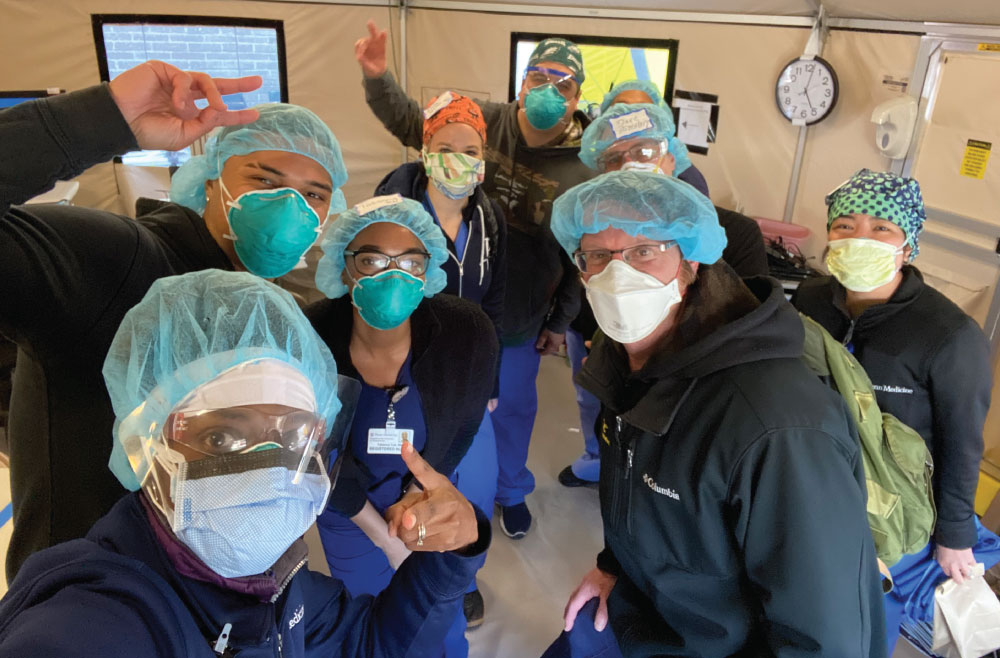
When a crisis hits, helpers go where the help is needed. And for many Penn Medicine staff, they did it in a systematic and organized way. For example, chemotherapy nurses from outpatient practices went to patient homes to provide life-saving infusions. Patient service associates (PSAs) worked at the COVID testing site at Penn Medicine Radnor doing thermal screenings and running to patient cars to gather demographic information and then running it back inside to the PSAs doing check-in.
Responding to this challenge required many parts of a puzzle to come together. It began with creating a three-tiered workforce redeployment process — for within departments, within entities (CPUP Workforce Redeployment Center) and on a systemwide level (Enterprise Workforce Redeployment Center). To ensure its success, several things were put in place, such as an online request form, assignment teams (physician, licensed professionals, non-licensed professionals), and a real-time dashboard to keep everyone up to speed.
Stay up-to-date with our COVID-19 response efforts by reading the COVID-19 Daily Update sent to you via email every day. Bookmark the COVID-19 Intranet site by going to What’s Hot and clicking on COVID-19 Updates just below the header. June is National Employee Health and Well-being Month
One of the initiatives that benefitted were the Influenza Like Illness (ILI) ED Surge Tents. As the Health System was gearing up for the potential “surge” of COVID-19 patients, several Penn Medicine emergency departments (EDs) prepared for the possible influx of patients by erecting tents as a staging area to help reduce the risk of infection in the hospital. They were able to triage and treat symptomatic patients before they entered, sometimes preventing an ED admission altogether.
To find adequate resources for these tents would be nothing short of a Herculean feat. For the ILI ED Surge Tents at HUP and PPMC, Heather Smith, RN, MJ, business director of HUP’s Cardiovascular, Thoracic, Transplant & Vascular Surgery and Rachel Kanter, MSN, RN, clinical manager of the Spine Access Center worked with the Enterprise Workforce Redeployment Center to help staff up and train as many employees as possible.
“This was certainly an ‘all hands on deck’ situation to provide ample staff and operationalize the care inside the tents,” Kanter said. “Overall, the process was seamless — we submitted our request and then we were given a roster of staff who we were able to train and put to work. We truly wouldn’t have been able to do it without the centralized redeployment efforts.”
In addition, support from CPUP leadership, EHR Transformation, Nursing Professional Development and the Center for Health Care Innovation were instrumental with many of the key processes: onboarding, regulatory, and general operations.
It was an amazing accomplishment to stand up these tents in very short order but it was the collaboration and comradery among the staff that was the most special to witness. Clinical staff including nurses, APPs, MAs, LPNs, residents, fellows and attendings came together from our various CPUP practices to support the tetnts staffing needs. The Departments of Medicine, Surgery, Orthopaedics, Neurology, Podiatry, Family Medicine and Community Health, and Ophthalmology were all represented.
“Every single team member had to learn a brand new process,” Kanter said. “Witnessing their flexibility, positive attitudes and dedication to the greater cause was very inspiring.”
Fortunately, with consistently low volumes, the decision was made to transition the tents back to ED management and staffing. As the Health System continues to navigate this pandemic and monitor volumes, tent usage will be reevaluated if there are predictions of a COVID surge on the horizon.